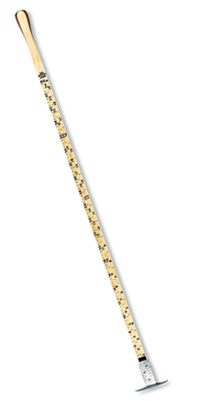Question
How do you calculate board footage? Do you calculate board footage using 4/4, 5/4, 6/4, and so on for thickness dimensions? Or do you use the actual width (for example, 4/4 is actually 1 1/8 inches thick)? The Wood-Mizer scale that was posted here just multiplies width x thickness x length (in inches) divided by 144; however, from the reading I have done, that is not how it is calculated. A lot of customers rely on 144 cubic inches = 1 board foot.
Forum Responses
From WOODWEB's Sawing and Drying Forum
There is only one way to measure the footage of hardwood *lumber* (and another for softwood). This technique is subscribed to by all the Departments of Commerce in all the states. It is simple. Any variations are a violation of state's weights and measures laws.
For hardwoods: First, you need to use the standard length (4', 5', 6', etc. and not include any inches over the standard length). However, 12'11" is still 12'. Then multiply by the actual width in inches and fractions and then divide by 12. Now round to the closest whole number. This is called the surface measure (SM). If you have several pieces of the same thickness, add up all their SMs. Finally, multiply by the *standard* thickness in inches (not actual). So, a piece 1-7/32" thick is 4/4, so the multiplier is 1. Apices 1-15/32 is 5/4, so use 1.25. The final answer is a whole number and not fractions.
For softwoods, you would use the standard width (not actual). You would also use two decimal places for SM and BF. Otherwise, it is the same as for hardwoods.
Did the scale that was posted calculate for lumber or for *logs*?
Most mills do not calculate board footage, but use a small stick of wood that has the footage numbers already on it (silk-screened). The stick is called a lumber rule. The calculations above for hardwoods and the stick agree 100%. You can also get this rule in a "steel-tape" version.

Gene Wengert, forum technical advisor
However, hardwood lumber would not be usually manufactured to exactly 8.0" wide, but would be random width. So, half of the pieces would be under 5.000 BF and half would be over. If you are making something like finished lumber and selling it by the piece, certainly you can adjust the price per piece as needed.
Note that a 1 x 7.00" x 8' has 5 BF (or using decimals, 4.67 BF per piece). Are you planning to sell this at a lower cost?
Gene Wengert, forum technical advisor
(Note: For wood under 1.00" thick, when measuring BF, you always use 1.00 for thickness. This means that when a piece that is 1-1/8" thick is resawn into two pieces, each about 1/2 inch thick, you will double the board footage!)
Gene Wengert, forum technical advisor
And if this is a 1 x 6 x 12 softwood, then the actual size could be 3/4" x 5.5" x 12' and still it is 6 BF.
Gene Wengert, forum technical advisor